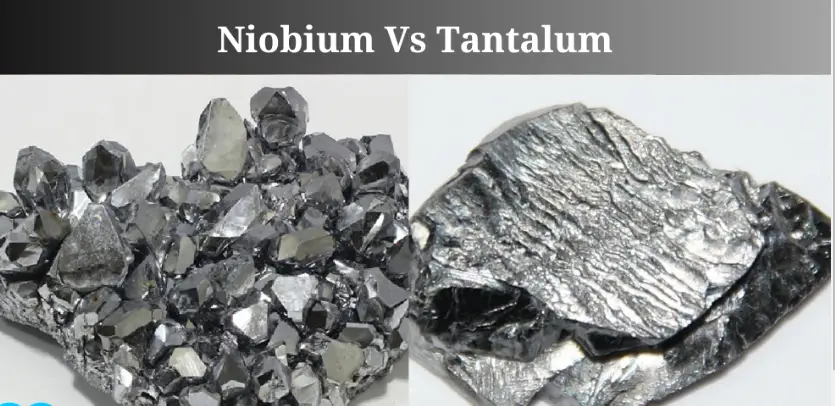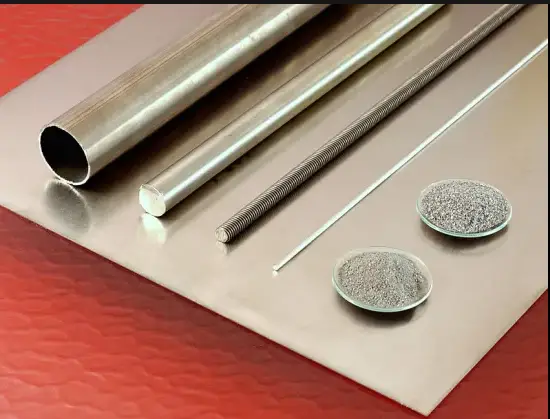Niobium and titanium are two elements that share some similarities but also possess distinct differences that make each unique in its own right. Known for their strength and resistance to corrosion, both metals find extensive use in various high-demand industries. While they often appear in similar contexts, understanding their distinct characteristics is essential for choosing the right material for specific applications.
Niobium is a rare, soft, gray metal, primarily used to produce high-strength steel alloys. Titanium, on the other hand, is as strong as steel but roughly 45% lighter, and it’s highly resistant to corrosion in sea water, aqua regia, and chlorine. The primary difference lies in their atomic structure, which imparts unique physical and chemical properties to each metal, influencing their utility in different industrial contexts.
As the world advances, the role of materials like niobium and titanium becomes increasingly critical. They not only support the demands of current technologies but also facilitate innovation in areas such as aerospace, medical devices, and beyond, making an understanding of their properties and applications essential.

Elemental Properties
Atomic Structure and Characteristics
Niobium and titanium are both transition metals with unique atomic structures that contribute to their distinctive properties. Niobium has an atomic number of 41 and features a configuration of [Kr]4d^45s^1. This configuration allows niobium to form a variety of oxidation states, commonly ranging from +2 to +5, which is essential for its role in superconducting materials and alloys.
Titanium, with an atomic number of 22, has the electron configuration [Ar]3d^24s^2. This structure provides titanium with a strong resistance to corrosion and the ability to withstand extreme temperatures without becoming brittle. Titanium’s notable strength-to-density ratio is due to this configuration, making it lighter and stronger than most other metals.
Physical Properties Comparison
When comparing niobium and titanium, several key physical properties are essential to consider:
- Density: Titanium is known for its low density, which is about 4.5 g/cm³, compared to niobium’s 8.57 g/cm³. This makes titanium ideal for applications where lightweight materials are crucial, such as in aerospace and automotive industries.
- Melting Point: Titanium has a melting point of 1668°C, which is lower than niobium’s 2477°C. This high melting point of niobium makes it suitable for high-temperature applications.
- Hardness: While both metals are strong, niobium is generally softer than titanium, making it easier to process and alloy with other metals.
- Corrosion Resistance: Titanium excels in corrosion resistance, especially against seawater and chlorides, hence its extensive use in marine environments.
Production Methods
Mining and Extraction Processes
Niobium is primarily obtained from the mineral pyrochlore, with major deposits found in Brazil and Canada. The mining process involves open-pit mining where the mineral-bearing rocks are crushed and subjected to a complex flotation process to extract niobium ore.
Titanium is mainly sourced from rutile and ilmenite mineral sands. These minerals are mined using dredging and dry mining techniques. The titanium-bearing ore is then separated from other minerals using a combination of magnetic, electrostatic and gravity separation techniques.
Refining Techniques
The refining process for both metals is crucial for their purity and final application:
- Niobium: The extraction from pyrochlore involves a series of chemical processes, including the use of hydrofluoric acid to produce niobium pentoxide, which is then reduced to metallic niobium using aluminum or sodium as reducing agents.
- Titanium: The Kroll process is the predominant method for refining titanium. It involves creating titanium tetrachloride (TiCl4) by chlorinating titanium-containing minerals. The TiCl4 is then reduced by magnesium, yielding titanium sponge which can be melted into bars or other forms.
Industrial Applications
Use in Aerospace
The aerospace industry benefits significantly from both niobium and titanium due to their resilience and lightweight nature. Titanium is widely used for aircraft frames and engines because of its strength and resistance to high temperatures. Niobium is used in jet engines and rocket subassemblies where its ability to maintain strength at high temperatures is crucial.
Medical Device Usage
In the medical field, both metals are highly valued for their biocompatibility. Titanium is used extensively for surgical implants such as joint replacements and dental implants due to its ability to osseointegrate, or bond, with bone. Niobium is utilized in similar applications, particularly in pacemakers and orthopedic implants, where its non-reactive nature is essential.
Consumer Electronics Roles
In consumer electronics, both metals play vital roles. Niobium is used in the manufacturing of capacitors and superconducting magnets, critical components in MRI machines and nuclear magnetic resonance instruments. Titanium is used in mobile phones and computers for its robustness and corrosion resistance, ensuring durability and longer product life.
Allergy and Biocompatibility
Skin Sensitivity Issues
Both niobium and titanium are known for their high biocompatibility, which makes them ideal for contact with human skin. Unlike other metals that might cause allergic reactions such as nickel or cobalt, niobium and titanium are hypoallergenic. This property is particularly crucial for products like jewelry and watches, which are in direct and prolonged contact with skin. For individuals with sensitive skin, these metals are preferred choices, minimizing the risk of dermatitis or allergic reactions.
Medical Implant Safety
In the realm of medical implants, the safety of the materials used is paramount. Titanium implants have been a cornerstone in orthopedics for decades, favored for their strength, lightweight nature, and, most importantly, excellent compatibility with human bone and tissue. Niobium also plays a critical role, especially in coatings for implants to enhance their integration into bone without inflammatory responses. Its usage in medical devices is a testament to its safety and reliability in sensitive applications.
Economic Factors
Market Availability and Pricing
Titanium and niobium are both relatively abundant in the earth’s crust, but their extraction and processing costs influence their market prices. Titanium, widely used and recognized, often has a higher price point due to its extensive processing requirements and the costs associated with the Kroll process. Niobium, while cheaper, still holds significant value due to its specialized applications in industries like aerospace and electronics. The pricing of these metals is subject to fluctuations based on market demand, mining output, and technological innovations in processing techniques.
Supply Chain Considerations
The supply chain for niobium and titanium is complex, involving numerous steps from mining to final product delivery. Both metals require specialized handling and transportation due to their reactive nature when unprocessed. Additionally, geopolitical factors can affect the supply chain, as major sources of niobium are concentrated in specific countries like Brazil. For titanium, the supply chain is more diversified globally, but still sensitive to disruptions in major producing countries such as Russia and China.
Environmental Impact
Extraction and Production Footprint
The environmental impact of extracting and processing niobium and titanium is significant. Mining activities disturb large areas of land and can lead to deforestation, soil erosion, and habitat loss. The chemical processes involved in extracting and refining these metals also pose challenges, including water pollution and hazardous waste production. Efforts to mitigate these impacts include improving mining practices and investing in technologies that reduce the environmental footprint.
Recycling and Sustainability Practices
Recycling niobium and titanium is a key component of reducing their environmental impact. Both metals can be recycled without degradation of their properties, which conserves natural resources and reduces energy consumption compared to primary production. Sustainable practices in the lifecycle of these metals not only involve recycling but also the development of more efficient and less pollutive extraction and processing methods.
Future Trends
Technological Advancements
The future of niobium and titanium in technological applications looks promising. Advances in additive manufacturing, commonly known as 3D printing, are set to broaden the scope of applications for these metals. Titanium, for example, is already being used to print complex parts for aerospace and medical applications, reducing waste and enabling more efficient designs. Niobium is being explored for its superconducting properties, potentially revolutionizing sectors such as energy transmission and magnetic levitation transport.
Emerging Uses in Industry
As industries evolve, so do the applications of niobium and titanium. In the energy sector, niobium is being studied for use in lithium-ion batteries to improve their performance. Titanium is finding new roles in environmental technology, including water treatment and air purification systems. The unique properties of these metals, combined with ongoing research, promise to unlock new, innovative uses that could reshape industries and contribute to a more sustainable future.
FAQs
What is Niobium?
Niobium is a chemical element with the symbol Nb and atomic number 41. It is a soft, grey, crystalline, ductile transition metal that is often found in the minerals pyrochlore and columbite, making up a small part of the Earth’s crust. It is used primarily in alloys, especially in steel to improve strength and welding properties.
How is Titanium Used?
Titanium is widely used for its strength-to-density ratio, the highest of any metallic element. In its unalloyed form, it’s as strong as some steels but less dense. It’s used in aircraft, spacecraft, and missiles where strong, lightweight, temperature-resistant materials are required.
Why Choose Niobium Over Titanium?
Choosing between niobium and titanium depends on the specific requirements of the application. Niobium is generally chosen for its superconductivity properties and its ability to improve the strength of steel at low concentrations, whereas titanium is preferred for its corrosion resistance and strength in lightweight applications.
Are Niobium and Titanium Biocompatible?
Both niobium and titanium are highly biocompatible, making them excellent choices for medical implants such as bone replacements and pacemakers. They do not react with body tissues and fluids, which prevents rejection and promotes healing.
Can Niobium and Titanium be Recycled?
Yes, both niobium and titanium can be recycled. Recycling these metals reduces the environmental impact associated with their extraction and processing. The recycling process involves melting down scrap metal and reforming it into new products, maintaining the properties that make these metals valuable.
Conclusion
Niobium and titanium are pivotal in the development of modern technologies due to their unique properties and wide range of applications. Each metal’s specific characteristics determine its suitability for different tasks, making an informed choice critical for optimal results.
The exploration of these metals not only enhances our understanding of material science but also pushes the boundaries of what is technologically achievable. As industries continue to evolve, the role of niobium and titanium is set to expand, underscoring the importance of these materials in future advancements.

